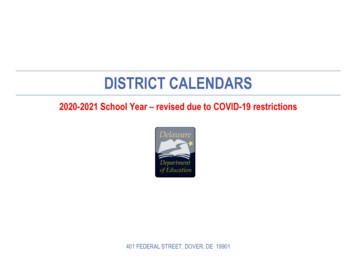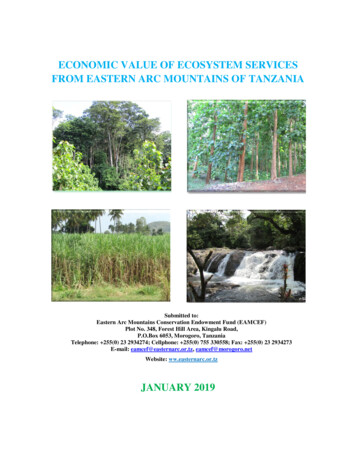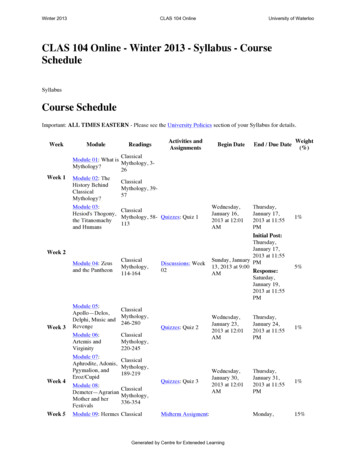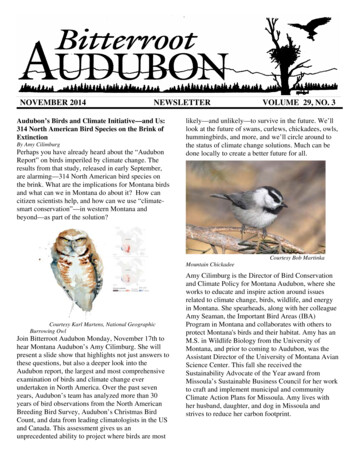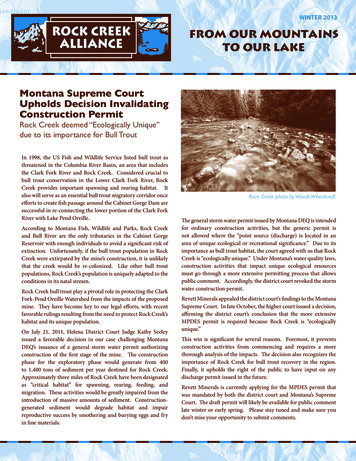
Transcription
WINTER 2013From our Mountainsto our lakeMontana Supreme CourtUpholds Decision InvalidatingConstruction PermitRock Creek deemed “Ecologically Unique”due to its importance for Bull TroutIn 1998, the US Fish and Wildlife Service listed bull trout asthreatened in the Columbia River Basin, an area that includesthe Clark Fork River and Rock Creek. Considered crucial tobull trout conservation in the Lower Clark Fork River, RockCreek provides important spawning and rearing habitat. Italso will serve as an essential bull trout migratory corridor onceefforts to create fish passage around the Cabinet Gorge Dam aresuccessful in re-connecting the lower portion of the Clark ForkRiver with Lake Pend Oreille.According to Montana Fish, Wildlife and Parks, Rock Creekand Bull River are the only tributaries in the Cabinet GorgeReservoir with enough individuals to avoid a significant risk ofextinction. Unfortunately, if the bull trout population in RockCreek were extirpated by the mine’s construction, it is unlikelythat the creek would be re-colonized. Like other bull troutpopulations, Rock Creek’s population is uniquely adapted to theconditions in its natal stream.Rock Creek bull trout play a pivotal role in protecting the ClarkFork-Pend Oreille Watershed from the impacts of the proposedmine. They have become key to our legal efforts, with recentfavorable rulings resulting from the need to protect Rock Creek’shabitat and its unique population.On July 21, 2011, Helena District Court Judge Kathy Seeleyissued a favorable decision in our case challenging MontanaDEQ’s issuance of a general storm water permit authorizingconstruction of the first stage of the mine. The constructionphase for the exploratory phase would generate from 400to 1,400 tons of sediment per year destined for Rock Creek.Approximately three miles of Rock Creek have been designatedas “critical habitat” for spawning, rearing, feeding, andmigration. These activities would be greatly impaired from theintroduction of massive amounts of sediment. Constructiongenerated sediment would degrade habitat and impairreproductive success by smothering and burying eggs and fryin fine materials.Rock Creek photo by Woods WheatcroftThe general storm water permit issued by Montana DEQ is intendedfor ordinary construction activities, but the generic permit isnot allowed where the “point source (discharge) is located in anarea of unique ecological or recreational significance.” Due to itsimportance as bull trout habitat, the court agreed with us that RockCreek is “ecologically unique.” Under Montana’s water quality laws,construction activities that impact unique ecological resourcesmust go through a more extensive permitting process that allowspublic comment. Accordingly, the district court revoked the stormwater construction permit.Revett Minerals appealed the district court’s findings to the MontanaSupreme Court. In late October, the higher court issued a decision,affirming the district court’s conclusion that the more extensiveMPDES permit is required because Rock Creek is “ecologicallyunique.”This win is significant for several reasons. Foremost, it preventsconstruction activities from commencing and requires a morethorough analysis of the impacts. The decision also recognizes theimportance of Rock Creek for bull trout recovery in the region.Finally, it upholds the right of the public to have input on anydischarge permit issued in the future.Revett Minerals is currently applying for the MPDES permit thatwas mandated by both the district court and Montana’s SupremeCourt. The draft permit will likely be available for public commentlate winter or early spring. Please stay tuned and make sure youdon’t miss your opportunity to submit comments.
Rock Creek AllianceRock Creek AllianceHolds Successful EventsThe Alliance recently held its annual party, followed by a cruise on Lake Pend Oreille. Thesupport of local businesses and individuals helped make these events both enjoyable andsuccessful. Many folks turned out for our annual event hosted by Pend d’ Oreille Winery.It was a beautiful evening and guests mingled outside while enjoying the music of WildHoney. Photographers Tim Cady and Jerry Pavia gave an informative slide presentation onthe International Selkirk Loop, and Alliance staff provided an update on the organization’swork. The winery served its Bistro Rouge wine accompanied by some mouth-wateringhors d’ oeuvres.Wild HoneyWe couldn’t have asked for a more perfect evening for our cruise on Lake Pend Oreille.Lake Pend Oreille Cruises generously donated the two-hour cruise and guests were treatedto a wonderful evening on our beautiful lake. DiLuna’s catered a delicious dinner for anevening that went by all too fast.NEPA: The NationalEnvironmental Policy Actmore than just list alternatives—they must “take a hard look”before issuing an approval.The US Forest Service (USFS) and Montana Department ofEnvironmental Quality will be making documents available tothe public that will influence the future of the proposed mine.The USFS will issue a Supplemental Final Environmental ImpactStatement (SFEIS), required as a result of our 2010 win infederal court. Also expected this winter is a Montana PollutionDischarge Elimination System (MPDES) permit, mandated byour recent win in Montana Supreme Court.NEPA also directs federal agencies to assist the public inunderstanding what a proponent of a project on federal landis proposing, and what “actions” the agency is considering.Under NEPA, we have an opportunity to offer our input on thevarious alternatives, and to critique the agency’s analyses of theenvironmental effects of the proposed action. The public oftenhas valuable information about places and resources they value,and the potential environmental impacts that proposed federalactions might have.The SFEIS is administered under a 42-year old law that is thebackbone of environmental protection in the United States, theNational Environmental Policy Act (NEPA).What is NEPA?Congress enacted NEPA in 1969, and President Nixon signed itinto law in 1970. NEPA was the first major environmental law inthe U.S. and is often called the “Magna Carta” of environmentallaws. Importantly, NEPA established this country’s nationalenvironmental policies.With few exceptions, all federal agencies must comply withNEPA before making decisions about projects significantlyaffecting public lands. The law requires agencies to considervarious alternatives in which a project could move forward,or not move forward (the No-Action Alternative), and theenvironmental impacts associated with each alternative. Ofsignificance is NEPA’s mandate to federal land managers to doRecently, legislation was passed by the House of Representativesto limit NEPA’s authority. The “National Strategic and CriticalMinerals Production Act of 2012,” would weaken NEPA by limitingor eliminating environmental review and public participationon proposed mining projects. The authors of this legislationintend to return to the days when environmental impacts wereconsidered secondary to an accelerated permitting process. Theproposed legislation, if passed by the Senate, would circumventyour right to have a say in projects such as the Rock Creek mine,and allow industrial interests to decide the fate of places like theCabinet Mountains Wilderness and Lake Pend Oreille.Please stay tuned for information about these importantcomment periods. We encourage you to provide us with a currentemail address so we can quickly alert you to your opportunityto have a say in the Rock Creek mine proposal. Your input iscritical because the Forest Service must consider all substantivecomments submitted by the public on the mine plan.
The Clark Fork RiverThe Clark Fork River provides 92% ofthe water entering Lake Pend Oreille,making it the most important source ofrecharge water for our lake. The riveris 320 miles long and over 300 of thosemiles are located in Montana. In orderto keep Lake Pend Oreille clean andhealthy, it is paramount that we protectthe water quality of the Clark ForkRiver in Idaho and Montana. Whilecleanup efforts are under way to remedypast environmental impacts to the river,it is equally important that decisions onnew sources of degradation are madewith due diligence.The largest Environmental ProtectionAgency (EPA) superfund site in thewestern United States is located inthe Clark Fork Basin. The complexstretches from the headwaters nearthe mining community of Butte to therecently removed Milltown Dam eastof Missoula. The superfund site wasdesignated in 1983 because of the toxicpollution created by historic coppermining in Montana.The Milltown Dam at the confluence ofthe Blackfoot and Clark Fork Rivers ispart of that superfund site. The dam wasremoved in 2010 because 6.6 millioncubic yards of sediment contaminatedwith arsenic, lead, zinc, copper, andother metals had accumulated behindthe 100-year old structure, and manyfeared the dam would eventuallybreach. Three million tons of sedimentwere removed and transported by railto Anaconda Smelter Superfund Site inMontana.stop at the cessation of a project. It isalso new sources of degradation like theproposed Rock Creek Mine that requirethe attention of those who work to keepthe river clean.Abandoned mines will continue toplague the water quality of the ClarkFork River because the perpetualnature of mining pollution meansthat the environmental impacts don’tWhile significant progress has beenmade in cleaning up the Clark ForkRiver, there is yet more to be done. Thegeography of our region dictates that allthose who appreciate a clean Lake PendClark Fork-Pend Oreille Basin by Land and Water Consulting, Inc.Oreille and Clark Fork River need to beactively involved in Montana politicsand environmental policy. Idaho candiligently and effectively work towardprotecting Lake Pend Oreille from localpollution sources, but all could be fornaught without an equal commitmentfrom Montana. The Clark Fork Riverknows no borders.From our Mountains to our lake
Rock Creek AllianceTimothy Preso—Championof Wildlife and Wild PlacesThe Rock Creek Alliance is extremely fortunate to be representedby several top-notch attorneys in our challenges in federal andstate court. We have featured two of our federal attorneys in priornewsletters. In this issue, we are profiling Timothy Preso. Tim isthe managing attorney in Earthjustice’s Northern Rockies regionaloffice headquartered in Bozeman, MT.Tim first fell in love with wilderness as a teenager growing up innortheastern Oregon. Places like the Eagle Cap and Hells Canyonwilderness areas helped inspire the appreciation for wild placesthat ultimately led him to a career focused on protecting specialplaces and their native wildlife.After graduating from Oregon State University, Tim took a job asa reporter covering environmental issues. While reporting on theplight of the Northern Spotted Owl from the logging of old-growthforests, he became convinced that legal challenges, brought byfirms like Earthjustice, are key to bringing about positive changeand protection of wild places and wildlife. This realization ledTim to a new direction in his career path.After earning a law degree from Georgetown University, Timbecame a law clerk in the U.S. Court of Appeals for the District ofColumbia Circuit. His next job was as an attorney with a privatelaw firm, but his passion for wild lands and wildlife drew himto take on an even larger caseload when he began representingDefenders of Wildlife in their quest to protect red wolves that hadbeen reintroduced to North Carolina. The litigation was successfuland red wolves remain part of the natural ecosystem in that state.Tim’s destiny to work as an attorney in an environmental lawfirm dedicated to the protection of wildlife, public lands, andnatural resources, ultimately led him to become an attorney withEarthjustice. In 2000, while contemplating his career move froma private firm, Earthjustice was looking to fill a vacancy in theirBozeman, Montana regional office. Tim returned to the West andlanded the job as a staff attorney. Tim became managing attorneyof the Bozeman Earthjustice office in April 2012.The wild places that Tim now calls home are part of the GreaterYellowstone Ecosystem, and he has worked tirelessly to protectthis area and other wild ecosystems throughout the West. Timhas represented the Rock CreekAlliance in our federal litigation onbehalf of threatened grizzly bears.He has successfully argued thatthe Rock Creek Biological Opinion for grizzly bears is based onflawed science, resulting in federal court rulings that remandedthe opinion back to the Fish and Wildlife Service on two differentoccasions.The Alliance is indebted to Tim for his commitment and passionin protecting the imperiled grizzly bears and their habitat in theCabinet Mountains Wilderness and surrounding public landsfrom the Rock Creek mine.photo by USFWS
Give-Away Spurs New Sense of Urgencyfor Mining ReformProfits for hard-rock mining companies extracting ore frompublic lands have reached record levels, soaring into the billions ofdollars annually. Under current regulations, the mining companiesoperating hard-rock mines on federal land are not required toquantify the amount or value of the minerals they extract.A new report, requested by Rep. Raul M. Grijalva (D-Ariz.) andSen. Tom Udall (D-N.M.), will spur a renewed push to reform the1872 Mining Law. Federal agencies generally don’t collect data onthe value of hard-rock minerals taken from public land becausehard-rock mines are exempt from paying royalties. The oil, naturalgas, and coal industries do pay royalties for production on federalland, and contributed 11.4 billion dollars to the federal treasurylast year.“This should be front and center of the natural resource agendafor this next administration,” Udall said in an interview. “Thesehard-rock minerals belong to the American people, and todaywe’re quite literally giving our gold and silver away.”Instead of recognizing the need to reform the antiquated mininglaw, the industry is pushing legislation to make it easier formining companies to obtain permits for projects by truncatingthe environmental evaluation process.Grijalva, who called mining firms “outright arrogant” for failingto disclose what they’re taking from public lands, said at aminimum these companies should report the volume and valueof what they’re extracting.2012 Board Of Directors CandidatesThe Rock Creek Alliance is governed by a board of directors,which is elected by its members. As a member, your vote isvery important to the operation of the organization. We askthat you please cast your vote and return your ballot to us NOLATER THAN January 22, 2013. We recommend that you votefor the individuals listed below.TWO-YEAR TERMJohn Edwards:I attended the University of Idaho from 1983 to 1988. Aftergraduation, I moved to the Garfield Bay area in Sagle. One ofthe main reasons for moving here was the big, beautiful pristinelake called Pend Oreille. Over the past twenty years, I have seenSandpoint and the surrounding areas prosper and grow. Thisgrowth has been based in recreation, retirement, and tourism.I know my business, Misty Mountain Furniture, would notexist without Lake Pend Oreille and its beautifully forestedwatersheds. The water quality of our lake is the lifeblood of oureconomy and a direct indicator of our quality of life. Clean wateris worth more than gold (and copper and silver for that matter).The precedent set by allowing “under wilderness” mining has hugeimplications not only for the Cabinet Mountains Wilderness, butalso for the rest of our wilderness areas and national parks. Myfamily and I have contributed to the Rock Creek Alliance formany years and applaud RCA’s hard work and victories. I wouldbe honored to serve on the board and look forward to workingwith Rock Creek Alliance and the Board of Directors in findingways to engage the public and our politicians to stop this outrage.Diane Mosley:I reside in Heron, MT, downstream from the proposed RockCreek mine site. I have been involved in the Rock Creek minecampaign for the past 15 years. My family and I relocated to theClark Fork River Valley back in ‘94, drawn to this special placeby its incredible natural beauty, clean environment, outdoorcontinued on next pageFrom our Mountains to our lake
Rock Creek Alliancerecreation and quality of life. I served on RCA’s Board manyyears ago, and have continued to serve as its bookkeeper since it’sincorporation. I feel the threat from this precedent setting mineto be far-reaching. It not only seriously endangers the pristinehigh mountain lakes of the Cabinet Mountain Wilderness, theClark Fork River and Lake Pend Oreille, but all of our nationalparks and wilderness areas, since its permitting would set aprecedent allowing tunneling under a federally protected area.These areas are unique and vital to maintaining clean waterand the rich diversity of wildlife dependent on them. Priorgenerations identified their incredible value and set them apartto be protected for us. We have a responsibility to do the same forthe generations that will follow.ONE-YEAR TERMLinda Olson:I have lived in Bonner County for over 20 years, and protectingLake Pend Oreille has always been one of my biggest priorities.I take great pleasure in observing the birds and other wildlifethat frequent its shores, and cannot imagine our beautiful lakepolluted with mining waste. I served as secretary for the LakePend Oreille Idaho Club for 20 years, helping to promote theclub’s mission of conserving Lake Pend Oreille’s water quality andits vital fishery. For over ten years, I did the layout and graphicsfor the Rock Creek Alliance newsletter. I would like to continuemy commitment to the organization, and help further its goal ofstopping the Rock Creek mine, by serving on the board.Rich Del Carlo:My motivation for serving on the board comes from myknowledge and love of the outdoors. Whenever I enter into theCabinet Mts. for hiking, backpacking or huckleberry picking, Ialways have a new spiritual experience and see something evenmore beautiful than before. I have two passions that motivate meas an environmentalist; birds and trees. Birding is a hobby, andthe love of trees fits into my career as an arborist. These have givenme an understanding and appreciation of the ecology of the localforest. I read extensively about environmental issues, and firmlybelieve that a mine anywhere in the Cabinet Mts. will degradethe alpine environment and ultimately ruin water quality and theecology of the pristine fresh waters we are fortunate to have inthis part of the world. I believe that the Rock Creek Alliance hasdone, and continues to do, great work, and that the ultimate goalof keeping the mine out of Rock Creek is obtainable. My time isvaluable, so being involved in an organization that works hardand is productive is exciting and encouraging.Shakura Young:As a resident of Bonner County, I am very concerned about theimpacts of the Rock Creek mine on Lake Pend Oreille, and ourlocal economy. I believe that the mine’s perpetual pollutionwould be disastrous for our community. I have been a member ofthe Alliance and a volunteer for over ten years because I believe inthe goals of the organization. I am proud of the accomplishmentsthat all of us as supporters of Rock Creek Alliance have achievedover the years and believe we can continue to make great stridesin protecting Lake Pend Oreille from the proposed mine. I wouldlike to take my commitment to the organization to the next levelby serving on the Board of Directors.Rock Creek Alliance T-ShirtsIf you haven’t seen our newest T-Shirts, you’re in for a treat. Ourpigment-dyed shirts are offered in both a woman’s cut and a man’s cut.Men’s colors include “smoke” or “bluegrass,” and women’s are availablein “surf.” Shirts are priced at two for 25 or 15 each. To purchasea shirt, visit Outdoor Experience in Sandpoint, or give us a call at208-265-8272, and we’ll make arrangements to get a shirt to you.
Dear Member,As you peruse this newsletter, you will find articles on bull trout, legal rulings, federal legislation, and historicmining pollution. These articles all relate to water in some way. Whether it is safeguarding water for bull trout oryour right as a citizen to have meaningful input on the fate of the water in the Clark Fork-Pend Oreille Watershed,our work encompasses water and its protection. And, the tools we use involve science and the law. They are thefoundation of our work, and they are what we write about in reporting on our work to you our members.It might be easier to fill the pages of our newsletter editorializing on how we truly feel about the prospects of havinga massive hardrock mine blast its way beneath the Cabinet Mountains Wilderness, sending a stream of perpetualpollution into the Clark Fork River and ultimately into Lake Pend Oreille. It is, after all, the passion that we feelabout the special places we are trying to protect that drives us. This passion is at the heart of why we exist, as muchtoday as 17 years ago when many of us stood at public meetings in Noxon and Sandpoint expressing our deepestfears about what would happen if the Rock Creek mine should ever be built. It continues to fuel what we do, and weknow that it is what motivates you to support our work. It’s also why we are fortunate enough to have attorneys likeTim Preso. In this issue, you will read about Tim, who is working diligently to protect grizzly bears in the CabinetMountains Wilderness.On behalf of the Rock Creek Alliance, I want to thank you for your commitment to helping us stop the mine, andfor the fervor that you show for Lake Pend Oreille, the Cabinet Mountains Wilderness, and the magnificent wildlifethat make these places come alive. Taking such a public stand against the Rock Creek mine is made easier becausewe know that our members stand with us. My hope for the coming year is all of us will continue to hold theseplaces sacrosanct and fundamental to our happiness. In that way, we will never stop working to protect them.Best Wishes for the New Year,Mary CostelloExecutive DirectorFrom our Mountains to our lake
Non-Profit Org.US PostagePAIDPermit No. 208Sagle, ID 83860PO. Box 2636Sandpoint, ID 83864Current resident, or:Please note the date by your name to check yourmembership expiration date. Thank You!Protecting our water and Quality of lifeRock Creek Alliance is a non-profit organizationformed by citizens, conservationists, andoutdoor sports enthusiasts to protect our publiclands and water resources from proposedmining activities within the lower Clark ForkRiver—Lake Pend Oreille WatershedBoard of Directors:Rich Del Carlo, Sandpoint IDJohn Edwards, Sagle, IDJean Gerth, Sandpoint, IDDiane Mosley, Heron, MTLinda Olson, Sagle, IDStaff:Mary Crowe Costello, Executive DirectorJim Costello, Outreach & Communications Coordinatorwww.rockcreekalliance.orgFind us on
of Missoula. The superfund site was designated in 1983 because of the toxic pollution created by historic copper mining in Montana. The Milltown Dam at the confluence of the Blackfoot and Clark Fork Rivers is part of that superfund site. The dam was removed in 2010 because 6.6 million cubic yards of sediment contaminated
